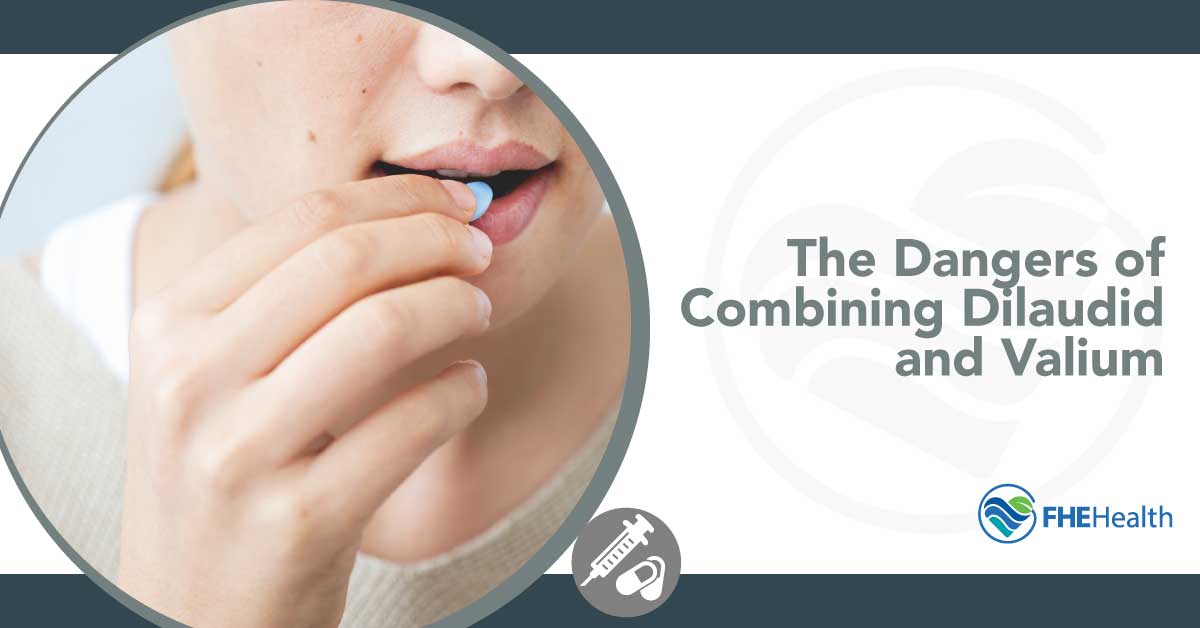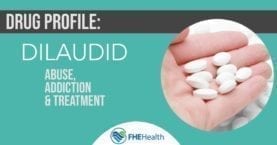
Drug interactions are nothing new. People have experienced the various side effects of taking medications since drugs were first prescribed. That’s why all prescription medications are required to carry warning labels and instructions about the distinct types of interactions, what to expect in the form of side effects, a detailed list of potential adverse reactions, and other information. Below is everything you need to know about the dangers of combining Dilaudid and Valium.
How Commonly are Dilaudid and Valium Combined?
When news reports of overdose deaths dominate the headlines, it’s usually not for long. The news media quickly moves on to the next breaking story. Tragically, Dilaudid and Valium overdose deaths, especially when consumed while drinking or taking other drugs, are more often underreported. Many more instances of individuals taking hydromorphone and diazepam never become known, and the behavior continues uninterrupted. Thus, the full extent of the occurrences of combining Dilaudid and Valium is not clear.
What is known from the 2019 National Survey on Drug Use and Health (NSDUH) is that misuse of benzodiazepines among those ages 12 and older was 4.8 million people in 2019 (compared to 5.5 million in 2015). With narcotic painkillers, including Dilaudid, 9.7 million people were abusing these drugs in 2019, compared to a 2015 total of 12.5 million people abusing them.
Prescription drug misuse is the most common type of illicit drug use after marijuana. The prevalence of benzodiazepine prescribing is highest among adults over the age of 65. Accompanying this increase is the increase in the number and severity of adverse events. This is especially pronounced among those individuals co-prescribed opiate painkillers and benzodiazepines like Dilaudid and Valium.
Elderly adults, who may be taking multiple medications for several medical conditions, are more likely to experience impairment in thinking, become confused, and have problems with motor coordination.
The Effects of Dilaudid
Hydromorphone hydrochloride is an active ingredient in Dilaudid. Under the Controlled Substances Act, hydromorphone is a Schedule II-controlled substance. Doctors may prescribe a drug containing hydromorphone for individuals experiencing pain. A potent opiate painkiller, Dilaudid helps dull pain. In that sense, it’s useful and prescribed for acute pain in some individuals. For example, following surgery, a doctor may prescribe the narcotic Dilaudid as a short-term aid to alleviate pain while the individual recovers from the surgical procedure and begins the healing process. Dilaudid is also prescribed for those with chronic pain, for which other analgesics are deemed insufficient or have ceased to work.
Too often in the case of painkillers, however, individuals develop a physical dependence on them which leads to tolerance, taking more of the drug more often. Addiction can result from this behavior.
Dilaudid also poses risks to pregnant women. Taking the drug while pregnant could result in a neonatal opioid withdrawal syndrome in the unborn infant. This condition is potentially life-threatening and requires early recognition and treatment by medical professionals.
Common adverse reactions of hydromorphone include:
- Feeling lightheaded
- Dizziness
- Nausea
- Vomiting
- Sedation
- Dry mouth
- Sweating
- Euphoria
- Flushing
Severe side effects requiring immediate medical attention include irregular heartbeat, chest pain or discomfort, black or bloody stools, rapid breathing, fainting, thoughts of self-harm, or suicidal ideation.
Physiological dependence, as well as psychological dependence, is a known risk associated with prolonged hydromorphone use.
Valium and its Effects
Diazepam is an active ingredient in Valium, a benzodiazepine drug. Diazepam is a Schedule IV-controlled substance. People with anxiety or stress may be prescribed Valium by their doctors to help them alleviate debilitating symptoms. It’s also prescribed in the treatment of alcohol withdrawal, and seizures, to relieve muscle spasms, and in preparation for surgical procedures.
Valium is a sedative and tends to calm the user. While this state of calmness is beneficial in reducing anxiety and stress, users can become so complacent about their drug use that they believe they can take more of it whenever they feel the need. Their cavalier attitude may extend to deliberate or unintended use when drinking alcohol or taking other medications, even prescribed drugs.
Is Valium safe? When the prescription drug is taken as the doctor prescribes and use doesn’t exceed the recommended dosage or duration of use, Valium is considered safe. However, individuals who are misusing Valium aren’t asking themselves if Valium is safe. They’re consumed with obtaining another prescription for the drug by doctor shopping, taking pills from friends or family, or getting it on the street.
Common Valium side effects include:
- Drowsiness
- Fatigue
- Muscle weakness
- Confusion
- Headache
- Slurred speech
- Blurred vision
- Hypotension
Psychological reactions may include hyperexcited states, agitation, aggressiveness, anxiety, irritability, restlessness, hallucinations, delusions, nightmares, insomnia, psychoses, and stimulation.
Continuing to use Valium or other benzodiazepines increases dependence risk and withdrawal. The longer someone uses or abuses Valium, the greater the risk of dependence. Abrupt cessation of Valium can result in acute withdrawal symptoms. These may be life-threatening.
How the Drugs Interact
Many prescription drugs have negative interactions, side effects, and adverse reactions. It’s worse when they are taken together. Worse yet, when either or both drugs are ingested along with alcohol, the effects can be potentially life-threatening. The interactions are often more pronounced among elderly adults who may forget what medications they’re on, take them more often than prescribed, or mix them with alcohol.
Compound Effects of Dilaudid and Valium
The great danger of combining Dilaudid and Valium is the risk of oversedation. Since both medications have strong sedative effects, increased drowsiness, and slow breathing, the user can suffer respiratory distress and overdose. They’re not able to respond to external stimuli and may fail to act in time to avoid an accident, in the event they are driving. If they are standing, they may fall, causing physical injury.
Further compound effects of taking Dilaudid and Valium include attention and concentration difficulties, dizziness, impairment in judgment, slowed reaction times, and impaired motor coordination.
Because of the effects of these drugs, users are cautioned not to drive or operate heavy machinery while they are taking the medications.
Why Someone may Seek that High
People in chronic pain or suffering from anxiety and stress don’t want to continue feeling that way. They want relief from their symptoms and have found what they believe to be the only way to do so: combining Dilaudid and Valium.
Why does anyone seek a high from misuse of prescription or illicit drugs? From many anecdotal reports, users say they want to escape, to numb themselves from physical and psychological pain. Emotions may be too intense, and they know that a quick way to calm the noise and stifle the overwhelming sadness, anxiety, and stress is to pop some diazepam and some hydromorphone. For some long-term users, Dilaudid and Valium not only have a prominent place in their medicine cabinet, but they’re also the go-to solution for almost any uncomfortable or disturbing situation, fleeting worry, or real or imagined pain.
According to the 2019 NSDUH, when asked why they misused drugs, respondents indicated the following reasons:
- To relax, relieve tension
- To get high
- To experiment
- To sleep
- For emotions
- To counter other drugs’ effects
- Because they felt they were hooked
Dangers of Mixing These Drugs Outside of a Prescribed Setting
Taking Dilaudid and Valium anywhere other than in a prescribed setting where the effects can be monitored is a high-risk practice. Combining hydromorphone and diazepam can have life-threatening consequences that include respiratory distress, falling into a coma, and death. Also, addiction to one or both substances is a risk. The longer someone mixes these powerful medications, Dilaudid and Valium, the greater the risk that physiological and psychological dependence and addiction develop.
When It’s Time to Seek Help
Finding yourself in situations where you are mixing Dilaudid and Valium is happening regularly is a sign of a larger problem. Other daily life aspects may be in disarray as well. These include relationship difficulties, problems at work, feeling depressed, anxious, or out of it, and engaging in other addictive or self-destructive behaviors such as excessive drinking.
If you or someone close to you is wondering if your use of Dilaudid and Valium may be causing problems, it may be time to seek help. At FHE Health, our caring and compassionate staff is dedicated to ensuring quality treatment for a Dilaudid and Valium problem or another drug or alcohol abuse issue. Contact us today to begin the healing process and recover the life you deserve.









